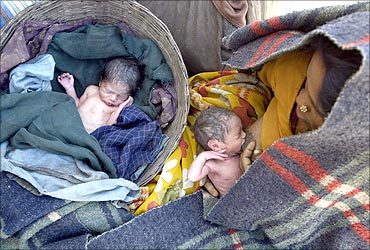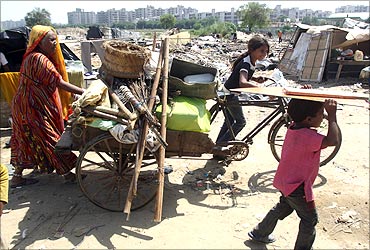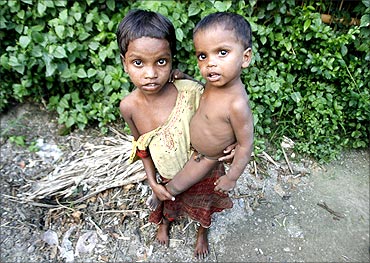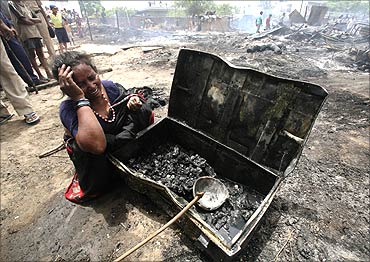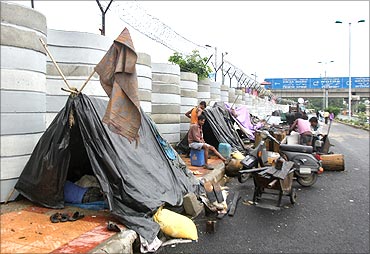 | « Back to article | Print this article |
When will India see a better tomorrow?
India's battle for a better lot for its people is barely half done, or may be even less, says Subir Roy.
The latest Human Development Report, or HDR, (2010), marking its 20th anniversary, is both remarkable and useful.
Remarkable because it brims with intellectual confidence, born out of a sense of vindication over the "conceptual brilliance and continued relevance" of Mahbub ul-Huq's original human development paradigm set out in the first sentence of the 1990 report - "People are the real wealth of nations."
Click NEXT to read on...
When will India see a better tomorrow?
The report is useful for India because it really does leave behind the controversy that has surrounded the measurement of poverty and its supposed level of reduction under the new economic policies initiated in the 90s.
Click NEXT to read on
When will India see a better tomorrow?
A majority agreed but not all were convinced that those numbers painted too rosy a picture, particularly for rural India.
Click on NEXT to read more...
When will India see a better tomorrow?
Today, matters like choice of poverty line seem irrelevant.
The HDR tells so much more, establishing the primacy of the idea that what matters is whether people can lead long, useful lives, get the opportunity to become educated and are able to use their knowledge and talents to shape their own lives.
The latest report, as part of the continuing effort to adopt more sophisticated and comprehensive measures of well being and its obverse, deprivation, has added three new indexes - inequality adjusted HDI, gender inequality index and multidimensional poverty index.
Click NEXT to read on
When will India see a better tomorrow?
The gender inequality index is self-evident and underlines the idea that gender inequality lies at the core of a group's overall level of deprivation.
The multidimensional poverty index acknowledges that different deprivations (be they over health, education, housing and the like) make up the total burden and counting them individually makes for better measurement.
Click NEXT to read on
When will India see a better tomorrow?
In the two decades, among four countries which matter to India, Bangladesh has posted the maximum improvement in its HDI score, followed by China and Pakistan.
India brings up the rear, with only Sri Lanka faring poorer, presumably because it had already reached a high plateau when the period began.
Click NEXT to read on
When will India see a better tomorrow?
Sri Lanka and Bangladesh leave India, China and Pakistan behind in scoring better through HDI rank than per capita gross-national-income rank.
Going by the income measure of poverty (purchasing power parity $1.25 per head per day), Sri Lanka and China are way ahead of India, which is followed by Bangladesh and Pakistan.
In terms of multidimensional poverty, it is only Bangladesh that is behind India, with even Pakistan scoring better, not to speak of China and Sri Lanka.
And in intensity of deprivation, not just China and Sri Lanka but Bangladesh also is ahead of India, with only Pakistan behind.
According to the inequality adjusted HDI, which captures the effect that inequality has on development, Sri Lanka and China again lead the pack, India and Bangladesh come next with Pakistan following.
Click NEXT to read on
When will India see a better tomorrow?
Pakistan and Bangladesh score only slightly better in gender equality than HDI rank. Startlingly, India's gender rank is lower than its HDI rank.
A third of the population of developing countries, totalling 1.75 billion, lives under the burden of multidimensional poverty and over half of this number is accounted for by South Asia, though poverty rates are higher in Sub-Saharan Africa.
People in Sub-Saharan Africa suffer the most from income inequality followed by South Asia.
Click NEXT to read on
When will India see a better tomorrow?
India loses 41 per cent of its HDI score due to educational inequality and 31 per cent on account of health inequality.
Eight Indian states, with over 400 million people who are as badly off as 26 of the poorest African countries, account for a larger number of the multidimensionally poor than the African countries.
The HDR finds that 40 years of learning and data indicate that "focusing exclusively on economic growth is problematic" and an unbalanced emphasis on growth is often associated with negative environmental and distributional consequences, as the cases of China and, to an extent, India indicate.
If growth is a means to various ends, "success" in growth must be seen to serve the broader human development goals that growth aims to achieve.
Click NEXT to read on
When will India see a better tomorrow?
Their health and educational levels are enormously important and progress on these fronts can happen even when growth is elusive.
Near universal as these paradigms are becoming, they should not be applied thoughtlessly as formulae. Context matters.
Technocratic solutions which assume a well-functioning state and regulatory system and developed institutions can come unstuck in the absence of those.
It is thus vital to experiment and learn, as the Chinese have done. Thus, India's battle for a better lot for its people is barely half done, or may be even less.
Click NEXT to read on...


